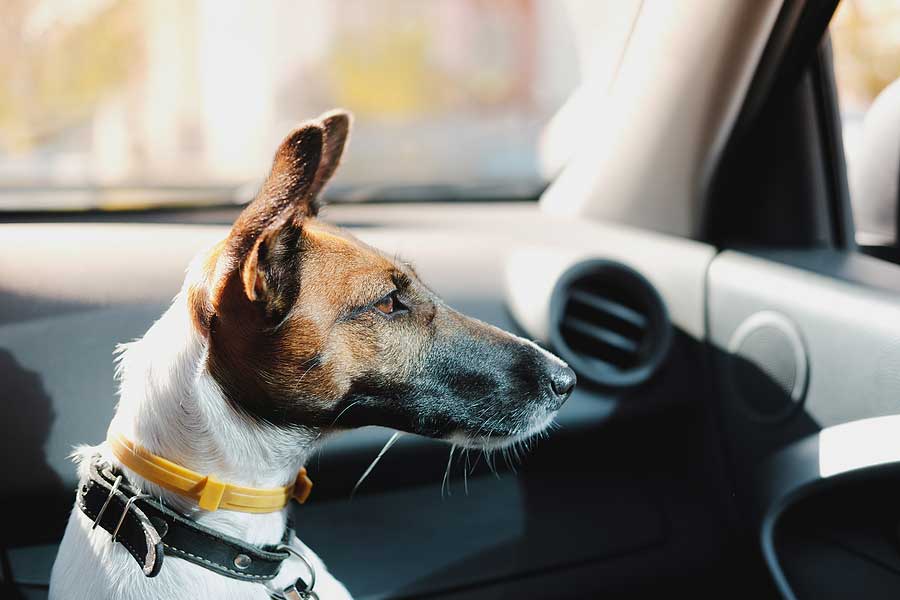
Dog Heat Stroke: Outside and In (the Car)
Although this current year of 2020 has led to restrictions in how we can enjoy it, this summer is no less a time that most folks enjoy getting outside. Every summer, without fail, I treat dogs for heat exhaustion and even the more serious life-threatening condition of dog heat stroke.
And unfortunately, there’s always a news article that pops up this time of year about the dangers of warmer weather for dogs and humans alike, recounting recent tragedies of pets and infants passing away from heat-related illness after being kept in hot cars, even during ""quick"" errands.
In this article, we’re going to discuss the very real and serious topic of heat-related illness in dogs, especially the dangers of keeping a pet locked in a car during balmy weather. We’ll also review some steps to take if you encounter a pet locked in a car and what you should do.
Why is Heat Dangerous for Dogs?
Panting and Sweating: Evaporative Cooling
Most living creatures have some kind of adaptation to help them cope with changes in ambient temperature. We humans have the important (but sometimes distasteful) ability to sweat through the glands in our skin which helps us to thermoregulate.
Sweating helps to cool us down through evaporative cooling. When we sweat, the droplets on our skin evaporate into the surrounding air, leading to a drop in temperature. Horses have this ability as well, hence the need for a ""sweat scraper"" in every equine aficionado’s supply.
But dogs are a little different. Dogs only have the ability to sweat just a little from glands on the bottoms of their feet, on their paw pads. But they don’t sweat nearly enough from these glands to burn off heat.
A dog’s main way of cooling down is through panting. When a dog pants, she brings in warmer air, but as it passes over the tongue, the moisture on the tongue and in the mouth evaporates, cooling the air as it is pulled into the lungs.
Evaporative cooling is a great way to chill out the body, but has its limitations, even for people. Sweating only continues to work as long as the body continues to produce sweat. Constant sweating will lead to dehydration if the body’s water is not replenished.
The same can go for dogs. If a dog becomes dehydrated, the evaporative cooling of panting will become less effective.
Humid weather also makes evaporative cooling less effective too. In an environment with dry heat, the moisture of sweat on the skin or saliva on the tongue can evaporate easily. But if there’s a lot of moisture already in the air, as on humid days, the moisture being released from the body really doesn’t have anywhere to go.
At humidity levels over 35%, evaporative cooling mechanisms start to be affected and studies have shown that humidity over 80% actually negates evaporative cooling entirely.
Like an Oven: Thermal Damage
Besides the risks of less efficient cooling and dehydration, outdoor heat can also directly cause something called thermal damage.
Extreme heat can directly impact tissues within the body. Think about how an oven cooks food. Meat and veggies just simply aren’t the same after baking because their very cell structures and proteins have been altered by the heat.
Or, for another example, take a look at your garden if you have one. Our plants and flowers do pretty well through early summer, but when temperatures consistently hit the 80s and 90s, leaves wilt and flowers start to brown at the edges. Even with extra watering, you’ll still lose plants unless they’re moved to a more shaded area, because of the direct heat they’re exposed to.
In a dog, heat can lead to direct damage in the bone marrow, where blood cells are generated, and in organs like the liver, which is responsible for a whole heap of important functions.
When you combine the limitations of evaporative cooling with the effects of direct thermal damage to body tissues, you can begin to understand why heat related illness is so common and dangerous.
But that’s just for the outdoors. Now consider taking a dog under these conditions and putting him in a small, enclosed space with poor ventilation, i.e. a car.
Why Being in a Car Makes it Worse

Cars are very good at trapping heat. Even on cloudy days, UV rays radiate through the windshield and windows, heating up elements inside, like the dashboard and upholstery. You’ll notice that no matter what time of year it is, it’s always at least a little warmer in your car than it is outside. But this difference between indoor and outdoor temperature escalates exponentially the warmer it is outside.
Consider some statistics from the Humane Society. When it’s a balmy 72 degrees outside (admittedly my favorite outdoor temperature), the interior of a car can actually heat up to over 110 degrees in the course of an hour.
And when it’s 80 degrees outside, less than 10 degrees hotter, the interior of your car can reach 100 degrees in less than 10 minutes. Even in temperatures as low as the 60s, vehicular heat-related deaths have been reported in children and pets.
So imagine at the peak of summer when it’s 90 to 100 degrees outside. According to noheatstroke.org, a non-profit dedicated to education and prevention of heat-related deaths in children left in hot cars, the indoor temperature of a car can reach 120 degrees in just 20 minutes if it’s 90 degrees outside. Within an hour, it’s over 130 degrees.
According to both noheatstroke.org and Consumer Reports, which did its own testing on ambient temperatures inside vehicles, cracking the windows a little doesn’t help very much. While this does help promote a little ventilation, ventilation isn’t as much the problem. The sun is still baking the interior of the car, with all the elements inside still constantly radiating heat.
This is also why air conditioning still isn’t a fail-safe to prevent heat-stroke in cars. Air-conditioning can malfunction, as was the sad case in a K9 police vehicle in 2018. Even if it doesn’t, heat-related deaths have still been reported in pets and children with the A/C running.
And while I don’t tend to refer to or quote PETA often, they do appear to keep the best running tally of heat-related deaths in pets, sourcing from news articles and press releases. For 2018 and 2019, this totals over 100 pets, with many more going unreported. Many hundreds more pets develop heat-related illness but are fortunate enough to recover.
A Personal Story: Ace the Survivor
Before we get into what you should do if you find a pet locked in a car, I’d like to share a personal story about one of my own patients, Ace, a 1 year-old German Shepherd Dog.
While Ace did not suffer heat stroke while in a locked car, the conditions in which he developed heat stroke wouldn’t be considered dangerous for many pet parents, and this really highlights just how insidious and dangerous heat-related illness truly is. Ace did make a complete recovery from his ordeal, but barely.
It was in the mid-summer several years ago when I was an intern doctor at an emergency hospital. Ace and his dad had gone out to a shaded trail in the early morning for a short jog, something they did several times a week. That morning, the temperature outside was in the upper 70s with a high humidity.
After only 20 minutes into the jog, Ace began to slow down, panting heavily. His dad walked him back to the car and they drove home. When they arrived, Ace went straight for the swimming pool and jumped in.
Over the course of the next hour, Ace’s family became keenly aware that something wasn’t right. Ace appeared very lethargic, even after jumping in the pool, remaining indoors, and drinking plenty of water.
Later that morning, he presented to my emergency hospital. One-year-old Shepherds are typically pretty active and high-strung dogs. But Ace just looked exhausted and uninterested in anything. His temperature was only a little high, around 102.9 (remember a dog’s temp can be normal at up to 102.5). But for a lethargic dog, that’s just not normal.
We already had a suspicion for heat-related illness based on the history Ace’s dad provided, but running bloodwork confirmed our worst concerns. His liver values were very elevated, a sign in this case of thermal injury. And even more concerning, he was mildly anemic and his platelets, the basic blood component needed for forming clots, were extremely low.
It became clear quickly what had happened. Although it was early and the outdoor temperature wasn’t extremely high, the higher humidity meant that Ace’s attempts to cool his body were less effective. And although he made attempts to cool himself off by jumping in the pool, making his body temperature almost normal, the thermal injury had already done its damage.
It was rough going with Ace. The biggest threat to his life was the consequence of the thermal injury he sustained. The changes with his blood counts meant that his bone marrow had been directly affected.
The thermal damage from heat stroke leads to an inflammatory reaction in the body that goes overboard. Blood flow becomes sluggish both from dehydration as well as thermal damage to the heart and circulatory system. The release of platelets that is stimulated in combination with blood flow changes leads to multiple blood clots forming all over the body. This leads to less oxygen to tissues.
This process of multiple blood clots forming is called disseminated intravascular coagulation, or DIC for short. Medical health professionals have another word for it: ""death is coming"". DIC often leads to multi-organ failure and resultant death.
But fortunately for Ace, death did not come despite multiple complications and set-backs. He developed a severe diarrhea from the shock of being in heat stroke, further dehydrating him. With platelets and clotting factors already used up, he ran the risk of developing uncontrolled bleeding. He developed a secondary infection and signs of kidney failure.
He required several transfusions with platelet-rich plasma, antibiotics, and a half dozen other medications. He was on continuous intravenous fluids and needed labwork repeated twice daily to try to catch any downfall in his fortunes early.
After about 3 days, we came very close to euthanizing him because his outlook appeared to be so bleak and he was only just hanging on. Every day I had to review the continued mounting costs of his care. But we gave him just a little more time, and by a miracle, largely due to his young age, otherwise excellent health, and his parents promptly getting him to the hospital, he began to turn the corner.
After a full week in the hospital, Ace was discharged in guarded but stable condition. We continued to provide care and follow up for about another month, but in the end, he made a full recovery.
Ace’s story is a success story, but a very cautionary tale. He was not locked in a car, he was out early in the morning on a shaded path, all reasonable precautions. He had only been active outdoors for 20 minutes. And yet, in spite of that, he still developed heat stroke.
Most dogs are not as lucky as Ace. The bodily effects of heat stroke and DIC can be delayed by several hours making it hard to tell that veterinary care is needed sooner. Most dogs that develop complications from heat stroke die within 24 hours. Ace’s parents recognized quickly that he wasn’t well. If they had delayed his care by even another hour, he might not have survived.
Ace developed severe heat stroke early in the morning at lower summer temperatures, out of direct sun, in only 20 minutes outdoors. Using that information, it’s easy to see how dogs locked in cars reaching over 100 degrees can quickly develop severe heat stroke and die in less than an hour.
How to Protect Your Pup and Others
Understanding the dangers and sometimes fatal consequences of heat-related injury, what are some steps you should take to protect your own pets?

Protecting Your Own Pup from Heat Stroke
- When temperatures get over 80 degrees during the day, take your pup for walks in the early morning and late evening, when temperatures are cooler. If humidity is approaching 50% or higher on warm days, Avoid anything more than a short 10 minute potty walk.
- Never leave a pet (or human child) unattended in a car if the outside temperature exceeds 65 degrees. Don’t rely on cracked windows or air conditioning, especially in really hot weather.
- Always make sure your pup has plenty of fresh water when outdoors. When traveling in the car, make sure to have an extra water bottle and a collapsible water bowl on hand for emergencies.
- It’s very important to have shade available for your pup whenever you’re outdoors. If you’re traveling and can’t be sure if shade will be available along the way or at your destination, there are lots of collapsible canopies and small tents designed for dogs. The best ones have a raised cot with a canopy over top, which allows for shade, plus good ventilation above and below.
- Heat shock proteins are proteins created within the body to protect against thermal injury. Dogs in consistently hotter climates have a greater proportion of them. Evidence shows however that it can take 10-20 days for a dog to adapt to a quick change in warmer weather by developing these protective proteins. In regions that can see frequent changes in temperature from week to week, like Virginia where I live, it’s really important to be aware of the time required for a dog to adapt. If it was in the fifties last week, it can be a mistake to pick that first 80 degree day in late spring to go for a 3 mile run with your pup.
- There can be many signs of heat stroke, ranging from excessive panting and lethargy, like Ace showed, to vomiting and diarrhea, and even neurologic signs like tremors and seizures. If you see even just that your pup looks more tired than normal after activity outdoors or being in the car, it’s better to be safe and have your vet make sure nothing is seriously wrong.
- Most first aid attempts, like applying cold wet towels and ice packs have limitations. A cold wet towel can be helpful at first, but will ultimately only serve to trap heat and prevent evaporative cooling. Ice packs may lower the temperature of extremities, but don’t decrease core body temperature.
- The best initial home remedy for an overheated dog is to spray him with cool (not cold) water (Ace did something similar by jumping in the pool). This will promote quick evaporative cooling over his whole body. But even this practice has limitations.
- The best overall initial treatment for heat stroke is intravenous fluids. IV fluids rehydrate all tissues in the body and in so doing, alleviate effects of thermal damage, help with blood flow, and reduce elevated core body temperature. This is one reason it’s important to get your pup to a vet if she’s suffering from heat stroke.
Protecting Other Pups: What to Do If You See a Dog Locked in a Car
Not everyone understands the dangers of outdoor heat. Most cases of heat stroke are not caused by an intentional cause to do harm. Some are certainly caused by negligence, but a majority are caused by mistakes and a poor understanding of the dangers. That’s why if we see another pet locked in a car when outdoor temperatures are dangerously high (and again, this might only mean temps in the high 60s or low 70s), it can be important to take some reasonable steps on their behalf. Early action can save a life.
- First, if the pet appears stable, take reasonable steps to locate the owner of the vehicle. If you’re parked in front of a particular store, this could mean finding the manager and providing the make, model, and license plate number of the vehicle to announce over the PA.
- If the owner of the vehicle cannot be located, contact local authorities using the non-emergency line. Some counties, like my own, have an animal protection police division that will respond to situations like this. Animal control authorities also commonly respond to these calls.
- If you have concerns about the pet’s stability and cannot locate the owner, just call 911. Many states have laws recognizing a pet being left in a locked car as a felony or misdemeanor if that pet comes to harm. No one will question you calling 911 in this situation. Police and/or firefighters will attend and have ways of legally entering a vehicle to remove a debilitated pet.
- After making attempts to contact the owner and/or contacting the authorities, make sure to stay with the vehicle until the owner or help arrives.
- The ability to legally take further action on your own depends on state laws, so it’s important to know what your local laws are. Some states have laws that will protect good Samaritans who enter a vehicle and remove a pet under duress. But others do not. In my state of Virginia for example, only official responders like firefighters, police, and animal control are protected if a vehicle is damaged to remove a pet.
Keeping Cool (You and Your Pup)
The key to preventing heat stroke in dogs is education. Many folks simply don’t realize the danger, especially in conditions they don’t consider to be dangerous. We all lead very busy lives and distractions are a constant reality.
If you feel a pet is in an unsafe situation, stay calm and raise your concerns with the pet parent. Most folks will be unaware of a problem and appreciate it was brought to their attention. If a pet remains in an unsafe situation and a pet parent is either unavailable or unwilling to intervene, call the appropriate authorities and let them handle it. We all care about animals but it doesn’t help to lose our cool, even in hot weather.
Last, make sure to take all of the proper precautions for your own pets this summer. Be mindful of not just temperature but humidity. Keep plenty of water and shade handy, portable if needed.
Even if we’re living under some restrictions this summer, it’s still the best time of year to enjoy friendship and companionship, especially with our pets. Keep cool and stay safe.
JOIN OUR PACK
Follow us @NaturVet on social media to fill us in on any tips we might have missed. And, check out the rest of NaturVet.com. We’ll keep you up to date on all our latest pet resources, supplements, tips and tricks, and more – everything you need to be the best pet parent possible.







